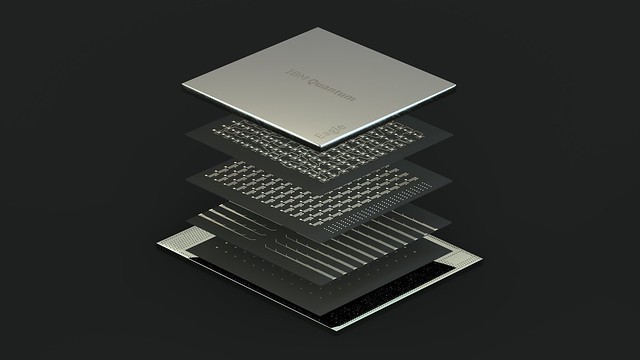IBM officially unveils Eagle processor, ushers in System Two era

IBM, in a move that will come as little surprise to recent IQT conference attendees–or really anyone who’s been following the quantum computing sector closely in recent months–officially launched its 127-qubit Eagle quantum processor.
The announcement, coming at the IBM Quantum Summit this week, pushes IBM quantum processors past the 100-qubit barrier for the first time. Bob Sutor, Chief Quantum Exponent at IBM, has talked about Eagle during presentations at the IQT Spring and Fall conferences this year, both times displaying an IBM quantum roadmap showing that the company would achieve 127 qubits in 2021.
IBM CEO Arvind Krishna actually announced the Eagle on Sunday before the IBM Summit during an Axios on HBO interview, which might be as clear a sign as any that quantum computing is seeping into popular culture as 2021 comes to a close.
Eagle’s qubit count is almost double the previous Hummingbird processor achievement of 65 qubits. The next quantum processor on the company’s roadmap, Osprey, is due next year with a planned 433 qubits, and IBM is aiming to surpass 1,000 qubits in 2023 with the Condor, which actually will weigh in at 1,121 qubits.
“Producing Eagle on our short timeline was possible in part thanks to IBM’s legacy of pioneering new science and investing in core hardware technology, including processes for reliable semiconductor manufacturing and packaging and bringing nascent products to market.,” an IBM blog post stated, later adding, “Eagle demonstrates how our team is solving challenges across hardware and software to eventually realize a quantum computer capable of solving practical problem in fields from renewable energy to finance and more.”
The company’s roadmap had previously stated that “novel packaging” would be a differentiating aspect of the Eagle processor, and in this phase IBM used “advanced 3D packaging techniques that we’re confident can form the backbone of processors up to and including our planned 1,000+ qubit Condor processor,” the blog post stated.
IBM said Eagle is based upon the heavy hexagonal qubit layout (sometimes called heavy hex lattice) that debuted with the company’s earlier Falcon processor. In this architecture, qubits connect with either two or three neighbors as if sitting upon the edges and corners of tessellated hexagons. This connectivity arrangement delivers lower potential for errors caused by interactions between neighboring qubits, translating to a significant functionality boost.
Eagle also incorporates readout multiplexing, first used in the Hummingbird processor, which allows the reduction of the electronics and wiring that typically would be required inside the dilution refrigerator for control and readout of each qubit–a task which becomes unmanageable as qubits rise into the hundreds.
Eagle also incorporates scalable access wiring to all qubits. 3D integration enables the placement of particular microwave circuit components and wiring on multiple physical levels, reducing the tangle of wiring that otherwise would occur at the edges. “While packaging qubits remains one of the largest challenges for future quantum computers, multi-level wiring and other components provide the techniques that make possible the path toward Condor, with minimal impact to individual qubit performance,” the blog post explained.
Quantum System Two
Also during the IBM Quantum Summit, the company unveiled its Quantum System Two system infrastructure plan (Previous quantum processors have been part of IBM Quantum System One.)
“Central to IBM Quantum System Two will be modularity,” the blog post stated. “With this system, we’re giving flexibility to our hardware to continue to increase the scale of our chips. The team is taking a holistic systems approach to understand the necessary resources to support not only our upcoming Osprey and Condor processors, but also quantum processors into the future, as we continue to progress along our hardware roadmap. System Two introduces a new generation of scalable qubit control electronics together with higher density cryogenic components and cabling.”
IBM also said it is working with Bluefors, the Finnish provider of cooling system technology, to “reimagine the cryogenic platform” for IBM quantum systems, a move that comes at a time when several companies are working on advancements to reduce cooling requirements for quantum computers and redesign systems to with networking in mind.
“Bluefors’ new cryogenic platform and its novel structural design optimizes space inside of the fridge in order to accommodate increased support hardware required by larger processors, while ensuring that engineers can easily access and service the hardware inside the fridge,” teh blog said. “This platform brings the possibility of providing a larger shared cryogenic workspace, opening the door to potential linking of quantum processors through novel interconnects. We think that System Two represents a glimpse into what the future of what quantum computing looks like—a true quantum data center.”























